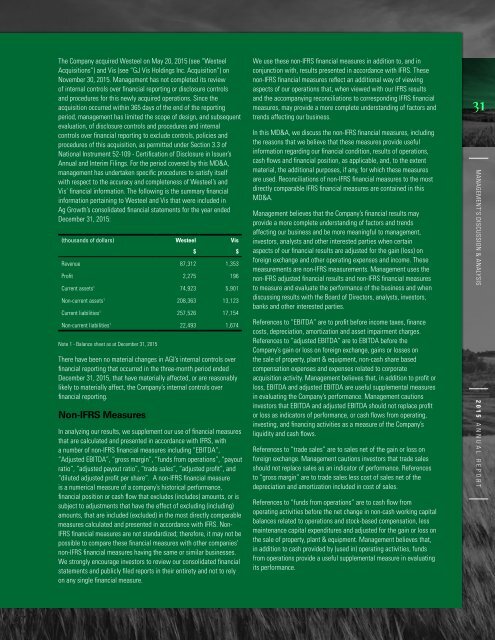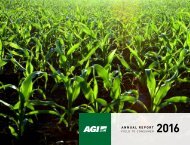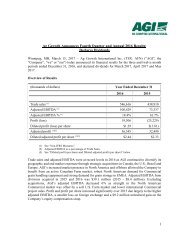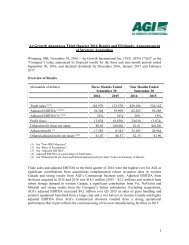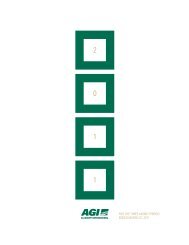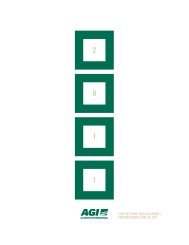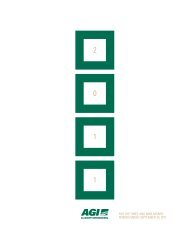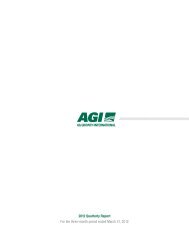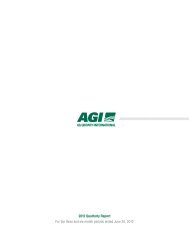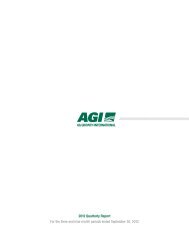Annual Report 2015
You also want an ePaper? Increase the reach of your titles
YUMPU automatically turns print PDFs into web optimized ePapers that Google loves.
The Company acquired Westeel on May 20, <strong>2015</strong> (see “Westeel<br />
Acquisitions”) and Vis (see “GJ Vis Holdings Inc. Acquisition”) on<br />
November 30, <strong>2015</strong>. Management has not completed its review<br />
of internal controls over financial reporting or disclosure controls<br />
and procedures for this newly acquired operations. Since the<br />
acquisition occurred within 365 days of the end of the reporting<br />
period, management has limited the scope of design, and subsequent<br />
evaluation, of disclosure controls and procedures and internal<br />
controls over financial reporting to exclude controls, policies and<br />
procedures of this acquisition, as permitted under Section 3.3 of<br />
National Instrument 52-109 - Certification of Disclosure in Issuer’s<br />
<strong>Annual</strong> and Interim Filings. For the period covered by this MD&A,<br />
management has undertaken specific procedures to satisfy itself<br />
with respect to the accuracy and completeness of Westeel’s and<br />
Vis’ financial information. The following is the summary financial<br />
information pertaining to Westeel and Vis that were included in<br />
Ag Growth’s consolidated financial statements for the year ended<br />
December 31, <strong>2015</strong>:<br />
(thousands of dollars) Westeel Vis<br />
$ $<br />
Revenue 87,312 1,353<br />
Profit 2,275 196<br />
Current assets 1 74,923 5,901<br />
Non-current assets 1 208,363 13,123<br />
Current liabilities 1 257,526 17,154<br />
Non-current liabilities 1 22,493 1,674<br />
Note 1 - Balance sheet as at December 31, <strong>2015</strong><br />
There have been no material changes in AGI’s internal controls over<br />
financial reporting that occurred in the three-month period ended<br />
December 31, <strong>2015</strong>, that have materially affected, or are reasonably<br />
likely to materially affect, the Company’s internal controls over<br />
financial reporting.<br />
Non-IFRS Measures<br />
In analyzing our results, we supplement our use of financial measures<br />
that are calculated and presented in accordance with IFRS, with<br />
a number of non-IFRS financial measures including “EBITDA”,<br />
“Adjusted EBITDA”, “gross margin”, “funds from operations”, “payout<br />
ratio”, “adjusted payout ratio”, “trade sales”, “adjusted profit”, and<br />
“diluted adjusted profit per share”. A non-IFRS financial measure<br />
is a numerical measure of a company’s historical performance,<br />
financial position or cash flow that excludes (includes) amounts, or is<br />
subject to adjustments that have the effect of excluding (including)<br />
amounts, that are included (excluded) in the most directly comparable<br />
measures calculated and presented in accordance with IFRS. Non-<br />
IFRS financial measures are not standardized; therefore, it may not be<br />
possible to compare these financial measures with other companies’<br />
non-IFRS financial measures having the same or similar businesses.<br />
We strongly encourage investors to review our consolidated financial<br />
statements and publicly filed reports in their entirety and not to rely<br />
on any single financial measure.<br />
We use these non-IFRS financial measures in addition to, and in<br />
conjunction with, results presented in accordance with IFRS. These<br />
non-IFRS financial measures reflect an additional way of viewing<br />
aspects of our operations that, when viewed with our IFRS results<br />
and the accompanying reconciliations to corresponding IFRS financial<br />
measures, may provide a more complete understanding of factors and<br />
trends affecting our business.<br />
In this MD&A, we discuss the non-IFRS financial measures, including<br />
the reasons that we believe that these measures provide useful<br />
information regarding our financial condition, results of operations,<br />
cash flows and financial position, as applicable, and, to the extent<br />
material, the additional purposes, if any, for which these measures<br />
are used. Reconciliations of non-IFRS financial measures to the most<br />
directly comparable IFRS financial measures are contained in this<br />
MD&A.<br />
Management believes that the Company’s financial results may<br />
provide a more complete understanding of factors and trends<br />
affecting our business and be more meaningful to management,<br />
investors, analysts and other interested parties when certain<br />
aspects of our financial results are adjusted for the gain (loss) on<br />
foreign exchange and other operating expenses and income. These<br />
measurements are non-IFRS measurements. Management uses the<br />
non-IFRS adjusted financial results and non-IFRS financial measures<br />
to measure and evaluate the performance of the business and when<br />
discussing results with the Board of Directors, analysts, investors,<br />
banks and other interested parties.<br />
References to “EBITDA” are to profit before income taxes, finance<br />
costs, depreciation, amortization and asset impairment charges.<br />
References to “adjusted EBITDA” are to EBITDA before the<br />
Company’s gain or loss on foreign exchange, gains or losses on<br />
the sale of property, plant & equipment, non-cash share based<br />
compensation expenses and expenses related to corporate<br />
acquisition activity. Management believes that, in addition to profit or<br />
loss, EBITDA and adjusted EBITDA are useful supplemental measures<br />
in evaluating the Company’s performance. Management cautions<br />
investors that EBITDA and adjusted EBITDA should not replace profit<br />
or loss as indicators of performance, or cash flows from operating,<br />
investing, and financing activities as a measure of the Company’s<br />
liquidity and cash flows.<br />
References to “trade sales” are to sales net of the gain or loss on<br />
foreign exchange. Management cautions investors that trade sales<br />
should not replace sales as an indicator of performance. References<br />
to “gross margin” are to trade sales less cost of sales net of the<br />
depreciation and amortization included in cost of sales.<br />
References to “funds from operations” are to cash flow from<br />
operating activities before the net change in non-cash working capital<br />
balances related to operations and stock-based compensation, less<br />
maintenance capital expenditures and adjusted for the gain or loss on<br />
the sale of property, plant & equipment. Management believes that,<br />
in addition to cash provided by (used in) operating activities, funds<br />
from operations provide a useful supplemental measure in evaluating<br />
its performance.<br />
31<br />
MANAGEMENT’S DISCUSSION & ANALYSIS <strong>2015</strong> ANNUAL REPORT


